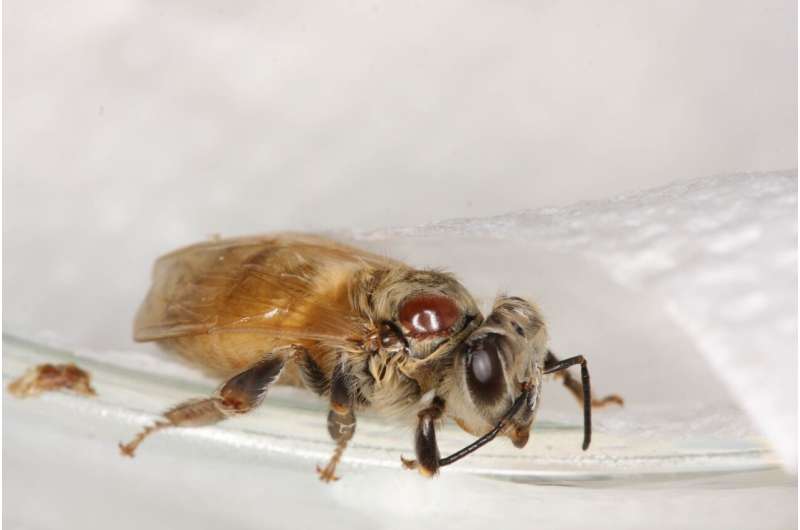A combination of insecticides and mites weakens honeybees

Today, scientists at the Institute of Bee Health of the University of Bern and the honeybee research association COLOSS have published an article in the peer-reviewed journal Scientific Reports that shows a synergistic time-lag interaction between the parasitic mite Varroa destructor and neonicotinoid insecticides reducing survival of winter honeybees, Apis mellifera. This article emphasizes the need to develop sustainable agricultural and apicultural schemes.
The Western honeybee is the most important managed pollinator globally and has recently experienced unsustainably high colony losses in many regions of the world. Synergistic interactions among stressors are believed to be primarily responsible. Despite the clear negative impact of certain neonicotinoids and the ubiquitous ectoparasitic mite Varroa destructor on exposed honeybees, no data existed to show synergistic effects between these two stressors.
Current data that was collected at the University of Bern and Agroscope, in cooperation with the Auburn University (U.S.) and Chiang Mai University (Thailand), suggest a novel, possibly previously overlooked, mechanism for recent unsustainably high losses of managed honeybee colonies. The results were published in Scientific Reports. According to the authors, the study underlines the importance of developing sustainable agro-ecosystem management schemes that incorporate reduced used of neonicotinoids and sustainable solutions for V. destructor mites.
A negative combination
Two stressors having a clear negative impact on the health of honeybees are insecticides and the ubiquitous ectoparasitic mite Varroa destructor. These mites originated from Asia, and have switched hosts from Eastern honeybees (Apis ceranato) to Western honeybees (Apis melliferato) to become the most serious biotic threat to Western honeybees globally. Similarly, there is evidence for the negative impact of widely used neonicotinoid insecticides. However, no data existed so far to show synergistic effects between these two stressors.
In the present work, honeybee colonies exposed to two neonicotinoids (thiamethoxam and clothianidin) via pollen paste feeding, did not affect honeybee worker mass or longevity. However, when in combination with V.destructor infestation, a synergistic negative effect was observed. Whilst a negative synergism was observed for body mass in both summer and autumn, it was only observed for survival 16 weeks post neonicotinoid colony exposure. The revealed results suggest a previously overlooked time-lag effect of neonicotinoid exposure. Because honeybee colonies in temperate regions must produce significant quantities of long-living winter bees to survive, the observed negative synergistic effects on individual winter honeybee longevity are most likely compromising colony survivorship.
Sustainable solutions required
"Beekeepers in many regions of the world face losses of their colonies, which are far too high," says Prof. Peter Neumann of the Institute of Bee Health at the University of Bern, co-author and president of COLOSS. Due to the present evidence for interactions between insecticides and mites, the authors stress the importance of developing sustainable agro-ecosystem management and varroa-management schemes. "Reduced usage of insecticides and sustainable solutions for V. destructor mites in agriculture and beekeeping are urgently required," adds Dr. Lars Straub, first author and Post-Doc at the Institute of Bee Health.
More information: Lars Straub et al. Neonicotinoids and ectoparasitic mites synergistically impact honeybees, Scientific Reports (2019). DOI: 10.1038/s41598-019-44207-1
Journal information: Scientific Reports
Provided by University of Bern


















